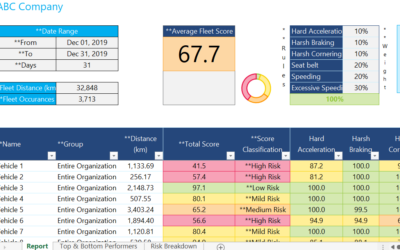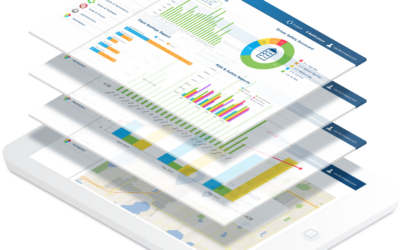How Can Telematics Help with Fleet Safety?
Fleet safety is among the biggest concerns for managers, which is why the particular emphasis is placed on implementing driver coaching and gamification strategies to improve driver behaviors. However, without obtaining the road realities, all methods to shape driver habits can be ineffective.
This has given rise to the idea of achieving fleet safety through telematics. The technology helps you collect the data needed to refine your fleet safety measures. Let’s see how.
Collecting Data about Driver Behavior
In fleet management, safety data has greatly evolved to shape the approach of organizations. In the beginning, the only focus was on spreading awareness about driver safety, giving rise to safety training and counseling. Next, the idea of monitoring driver behaviors was made possible by the use of telematics devices.
While telematics devices record various forms of data, you need to identify the right metrics that need to be tracked to ensure maximum fleet safety. These typically depend on the nature of the fleet but some commonly tracked data include driver behavior such as speeding, harsh braking, seat belt usage, hard cornering, etc.
Some of these mistakes are performed unknowingly by drivers as many of them don’t even realize what they’re doing wrong. And many of the poor behaviors are interrelated with each other. For instance, a driver who has a habit of harsh braking will also have poor vehicle control and won’t be able to avoid skidding.
Each metric tracked by a telematics device has its benefits. For instance, data about harsh braking will help drivers improve vehicle control, avoid brake issues such as failing brake discs and tire blowouts.
Likewise, overspeeding data help fleet managers carry out better monitoring and implement safety controls. When considered collectively, the metrics give an overview and present trends on driver behavior across the fleet as well as present insights into individual driver habits.
In this way, all guesswork is eliminated from drivers’ safety records as fleet managers have real instances of on-the-road behaviors to determine the strengths and weaknesses of individual drivers. Using the actionable information provided by telematics devices, managers can now provide personalized coaching to fleet drivers, which is more effective than other forms of driver training. This guarantees safer driving, improving business outcomes and greater opportunities.
The way it works is that the data collected for all the safety metrics are presented in a driver scorecard that assigns scores to specific driving practices.
Based on these scores, the overall driver rating is calculated for each driver. The definite metrics and rating procedure make driver monitoring way too easy. Without this mechanism, one can easily drown in tons of data. Fleet managers are now able to divert their focus from ‘making sense of the data’ to ‘coaching the drivers’ based on the ratings. But identifying the right metrics is the key.
The upcoming phase is all about artificial intelligence that will be incorporated into in-cab cameras to provide the precise picture of what’s happening on routes. The innovation will certainly help companies run an even safer fleet.
Telematics in Driver Coaching
The data collected through telematics devices are highly valuable for driver coaching. Driver coaching can greatly reduce the chances of accidents by identifying driver weaknesses and emphasizing improvements. Using telematics data alongside innovative dashcams can make coaching programs much more effective by providing pieces of evidence of specific driving practices.
However, what’s important to note here is that driver coaching should always be constructive instead of being punitive. With new tough regulations in place such as the Food Safety Modernization Act (FSMA) and hours-of-service, fleet companies can’t afford to lose drivers. While it is important to penalize poor driving practices through a fact-based approach, drivers should never be humiliated. Instead, you should emphasize their safety but what’s likely to bring the desired results is an incentive-based approach so that the drivers see some reason to improve their habits.
Thus, telematics technology shouldn’t be viewed as a means of shaming the drivers, but a tool to reward safe driving behaviors so that everyone, including the drivers, managers, clients, the business as a whole and the entire community, benefits from safe driving.
The bottom line is that your drivers should view the use of telematics in coaching programs as a bridge to achieve professional growth. Each program should imply that the company cares for the drivers and is concerned about their safety as well as their long-term success.
Gamification Strategies
Data obtained through telematics devices are an incredible source for applying gamification strategies. The biggest driver of improved driving habits is motivation, which can be boosted through competition. The competition spurred through gamification helps engage drivers in road safety in an impactful and meaningful way.
Various gamification strategies can be applied based on the rewards that will motivate the drivers. For instance, if your company comprises of multiple regional depots, you can set up a monthly competition among the depots, declaring that the depot with the least number of road accidents will be rewarded with a generous feast at the end of the month, and bonuses to top-performing drivers.
When organizing competitions aimed at improving driver behaviors, management should include all drivers. This can be done by splitting the reward based on points earned so more and more drivers earn the benefits. For instance, in a $400 contest, you can use a point-based system. $10 can be deducted for each road accident. At the end of the period, drivers with a perfect record will be rewarded full $400 while others will receive the balance after accident deductions.
Closing Thoughts
Driver safety is paramount in fleet management, for which telematics technology comes to a great rescue. The telematics data are tremendous assets to design driver coaching programs and applying gamification strategies.
Other benefits of safe driving include lower costs associated with vehicle crashes and liability, better driver retentions, reduced insurance premiums, all of which translate into better business outcomes. But we’re yet to discover more insights into fleet safety through telematics as it combines with AI in the upcoming years.
Source:
https://www.worktruckonline.com/339828/increasing-safety-through-telematics






